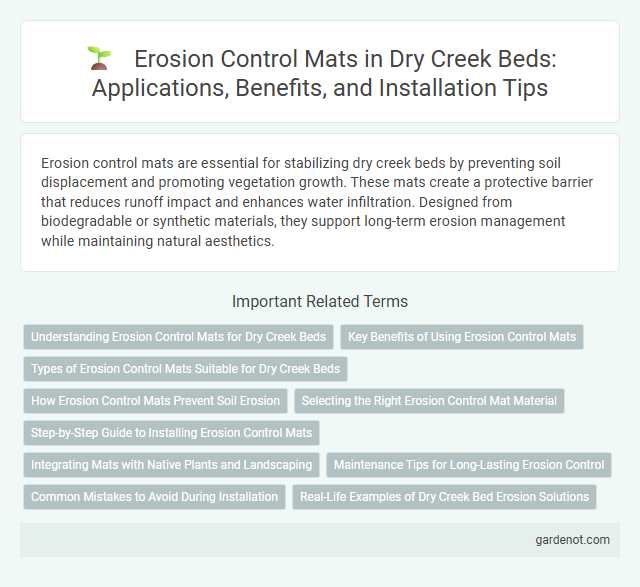Erosion control mats are essential for stabilizing dry creek beds by preventing soil displacement and promoting vegetation growth. These mats create a protective barrier that reduces runoff impact and enhances water infiltration. Designed from biodegradable or synthetic materials, they support long-term erosion management while maintaining natural aesthetics.
Understanding Erosion Control Mats for Dry Creek Beds
Erosion control mats are engineered to stabilize soil and prevent sediment displacement in dry creek beds, enhancing water infiltration and reducing surface runoff. These mats, made from biodegradable materials or synthetic fibers, promote vegetation growth by protecting root systems from erosion forces. Proper installation ensures durability against weather fluctuations and aids in maintaining the ecological balance of dry creek habitats.
Key Benefits of Using Erosion Control Mats
Erosion control mats effectively stabilize the soil in dry creek beds, preventing sediment runoff and reducing surface erosion. These mats enhance vegetation establishment by protecting seeds and young plants from wind and water displacement. Their biodegradable materials improve soil structure and promote long-term ecological restoration in vulnerable creek environments.
Types of Erosion Control Mats Suitable for Dry Creek Beds
Erosion control mats suitable for dry creek beds include coir mats, excelsior mats, and synthetic erosion control blankets, each designed to stabilize soil while allowing vegetation growth. Coir mats, made from coconut fibers, offer durability and bio-degradability, ideal for long-term erosion prevention in dry creek environments. Excelsior mats utilize wood excelsior fibers to provide effective erosion control and moisture retention, whereas synthetic blankets deliver enhanced strength and rapid installation for high-traffic or heavily eroding areas.
How Erosion Control Mats Prevent Soil Erosion
Erosion control mats stabilize soil in dry creek beds by providing a protective layer that reduces the impact of water runoff and wind. These mats help maintain soil structure and promote vegetation growth, which further anchors the soil in place. By minimizing soil displacement, erosion control mats effectively prevent sediment loss and preserve the natural landscape.
Selecting the Right Erosion Control Mat Material
Selecting the right erosion control mat material for a dry creek bed is crucial to prevent soil loss and promote vegetation growth. Biodegradable mats made from coconut coir or straw excel in natural environments, providing temporary stabilization while decomposing over time. Synthetic mats offer long-term durability and resistance to harsh weather, ideal for areas with heavy water flow and steep gradients.
Step-by-Step Guide to Installing Erosion Control Mats
Erosion control mats stabilize soil in dry creek beds by preventing runoff and reducing sediment loss. Begin installation by preparing the ground surface, removing debris, and grading to ensure proper water flow. Secure the mats using stakes or staples according to manufacturer guidelines, overlapping edges for complete coverage and long-term durability.
Integrating Mats with Native Plants and Landscaping
Erosion control mats combined with native plants stabilize dry creek beds by enhancing soil retention and reducing sediment runoff. Native vegetation roots penetrate mats, promoting natural water absorption and reinforcing soil structure against erosion. Integrating these mats within landscaping ensures sustainable creek bed restoration while maintaining ecological balance and habitat diversity.
Maintenance Tips for Long-Lasting Erosion Control
Regular inspection of erosion control mats in dry creek beds ensures early detection of wear or displacement, preventing soil exposure and erosion. Secure mat edges with staples or pins after heavy rainfall to maintain stability and promote vegetative growth underneath. Cleaning debris from mats prevents water flow obstruction, enhancing their effectiveness and longevity in controlling erosion.
Common Mistakes to Avoid During Installation
Incorrectly securing erosion control mats in a dry creek bed can lead to mat displacement and ineffective soil stabilization. Failing to remove debris and properly grade the area before installation often results in inadequate mat-to-soil contact, reducing erosion control effectiveness. Overlapping mats insufficiently or using incompatible anchoring methods risks water flow disruption and accelerated erosion around the mat edges.
Real-Life Examples of Dry Creek Bed Erosion Solutions
Erosion control mats have proven effective in stabilizing dry creek beds by securing soil and reducing surface runoff during heavy rains. In a recent California project, biodegradable erosion control mats helped restore a 500-foot dry creek bed, preventing sediment loss and promoting native vegetation growth within six months. Similar applications in Arizona demonstrated a 70% reduction in soil erosion rates, showcasing the mats' role in sustainable watershed management.
Erosion control mat Infographic

 gardenot.com
gardenot.com